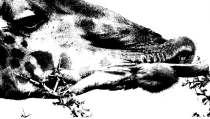on the African Plain
 When we were tads, they gave us well-sanitized books of animal photographs. It was expected that we would feel some anthropomophic connection with the cuddly monkeys, baby tigers, and austere ibis.
When we were tads, they gave us well-sanitized books of animal photographs. It was expected that we would feel some anthropomophic connection with the cuddly monkeys, baby tigers, and austere ibis.No longer. When he isn't doing close-ups of elephant droppings, urinating lionesses, or the flies on the face of a cub, Iwago wants us to see blood and bones in the high country: gazelles eviscerated before our eyes by wild dogs, lions chowing down on the skulls of baby zebras (jaws dripping with gore), hyenas being quite piggy over the bloody guts of some wildebeest torn apart for their --- and presumably our --- delectation. Burp. It's reality squared, and we don't know if we care for it at all.
And what we doubly don't care for are the dopey comments attached to these lush photographs.
"These remains of a wildebeest calf are a reminder that the young and the infirm are the first to perish in the Serengeti's harsh world."
Unh.
"Lions rarely eat for five to ten days when mating."
Neither do we.
"The zebras' coloring makes them highly visible during the day."
Figures.
"The lion's strong jaws are well suited to the needs of a predator."
Obviously not for smooching, eh?
The whole collection lacks rhythm and focus. It is a jumble of photographs --- some startlingly beautiful --- but all assembled without the organizational aesthetics necessary to honor something to which we can give the title "book."